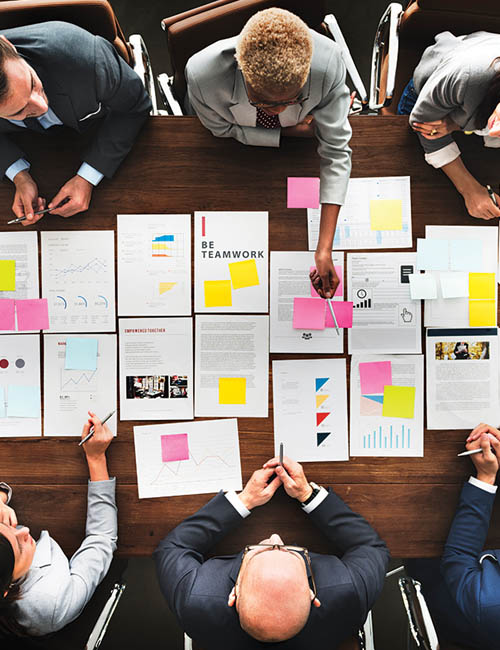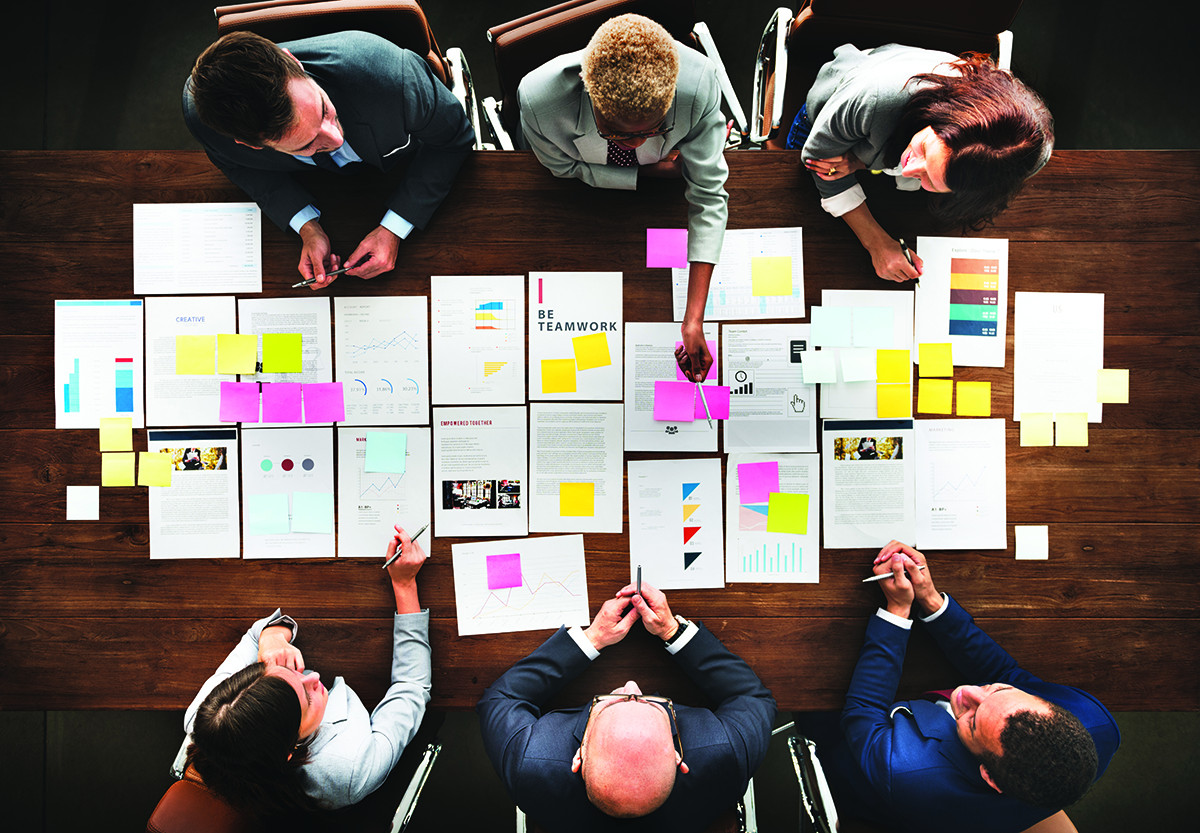Have you experienced the situation when the client’s team is stacked and sends the research team loads of ideas that just don’t work? This is exactly the moment to take a step aside and look at the situation from a fresh perspective.
It is time for a co-creation session. Co-creation sessions bring together a mix of stakeholders for the purpose of identifying new and creative ideas for the organization and its products/services. We have been working on co-creation sessions for the past seven years, and over this time we have developed a number of tips and tricks which have proven to work well for us when running these sessions. We’ve also learned what doesn’t work well for co-creation and what’s best to avoid. So, fasten your seat belt and let’s go on a journey of co-creation.
When to Use Co-Creation
We suggest holding a co-creation session under the following two scenarios: when clients provide their research brief looking for some innovative solutions (and are hoping that regular respondents will create it themselves), or when the brand team is struggling with internal development and can’t seem to move along.
Here are some of the key moments when we’ve used this approach:
- Crafting new product ideas and
concept development - Searching for new strategic benefit
- Generating out-of-box communi-
cation ideas - Profiling target groups and personas
- Exploring promotional ideas
- Ideating brand names
- Coming up with retail innovations
- Designing customer touchpoints
- Where a fresh point of view and creativity are needed
Getting Ready Is Half the Success
All the magic of successful co-creationstarts long before the actual event. Plan your session at least 3-4 weeks ahead as you need to answer several major questions:
- WHO – which participants will make your session a real success?
- PRE-TASK – make people think before the workshop—it really pays off.
- WHERE – select a location to inspire and energize participants.
Who Should Participate?
Consider inviting people with a non-standard profile, who are connected to the session topic in less direct ways. When we led a session focused on brand positioning for a well-known mineral water brand, looking for ideas on which the future campaign should be based, we invited an eclectic mix of people such as a “slammer poet” (somebody who creates poetry instantly on stage based on the theme from the audience), a movie director, and a well-known beauty YouTuber. Why them? They all are successful storytellers! And we needed good story ideas for brand positioning as well as campaign ideas.
Of course, we combined them with marketing experts, digital agency folks and production site managers (who can talk for hours about the quality of the spring water and its delicious taste). But believe it or not, the best ideas came from the storytellers who could see the brand from very different and mind-opening perspectives.
Another key question is whether and how to involve the internal team. On one hand, you need them in the session to be part of the development and feel ownership of the ideas. On the other hand, their thinking is often very limited as they tend to stay “inside the box” with existing ideas and an “we always do it like that” approach, which can limit the outcome of the entire session. So what to do? It can be solved many ways—but one way, which worked best for us, was connected to a very well-phrased pre-task.
Magic of the Pre-Task
Imagine that the clients could come up with new ideas on how to talk about their mineral water brand. But they also have the feeling that the water category is a total commodity market where nobody can differentiate anymore—quite a hard mindset in which to run a successful co-creation session and come up with breakthrough thinking.
Now imagine that you give them a pre-task to come up with examples on how any brand from any category successfully differentiated itself within a commodity market. You open the session with that and let everybody present and show their examples from categories like toilet paper. (What can be a bigger commodity?)
This task has uncovered great examples of how brands in commodity categories were able to create breakthrough ideas. For example, we learned how the ZEWA brand came up with a flushable paper roll which is left when all the paper is used up. In a different category, the Zapa Beton company, which produces cement and ready mixed concrete, painted all its vehicles and factories with fairy-tale characters, shapes, and colors. As a result, passing motorists and their kids get excited when they drive by the Zapa factory or pass their cement trucks on the highway.
After 30 minutes of presentations, the client team turned to us and said, “If they can do it, we can as well.” What a feeling of satisfaction and a great starting point to come up with some big ideas!
Here are some additional tips for designing the pre-task. First, think through your task design strategically. Keep your task simple; one question to answer is enough. To get the most out of the pre-task, focus it directly on the issue you want to solve. And be sure to leave time for participants to present their work so that everyone feels they got their one minute of fame.
Where to Run the Session
The right venue choice can make a huge impact on the outcome of the session. We always try to avoid running the session in the client’s office; instead, we try to bring the team to a place that stimulates creativity and out-of-the-box thinking.
Examples that proved to work well for us are business incubator offices for start-ups (which often rent the conference rooms and the vibe is very young and fresh), or a yacht parked on the river offering an outside area for breakout sessions (fresh air stimulates thinking, so why not use it?), or a cooking studio to run a hands-on cooking session when developing ideas for new product development in the syrup category. It can be anywhere; just be careful that the place works for the group’s meeting purpose. The place has to have enough space to move around, allow for teams to break out into smaller groups, project stimuli on the wall, etc. The creative feeling of the space should not be at the expense of its functionality.
Creative Tools to Get the Max Out of the Session
To stimulate the team’s creativity, you need to prepare the portfolio of tools that you will use during the workshop. We usually prepare 8-10 creative techniques, but often use just 3-4 of them during the session. We have all of them ready with short instructions on prepared slides, but the final selection is done during the session once we get a feeling of the team’s creativity, openness, and fit with the technique. Here are some examples, which proved to work for us:
a) Destroy the old brand to discover the new one. This ritual destruction of the brand works well when the team needs to get a fresh perspective. It can be quite a painful exercise for brand or marketing managers who feel strong ownership of the brand, but it helps to create space for new ideas. The graphic shown highlighting the Starbucks brand is an example of how this exercise could be used.
b) Dixit Cards Toolkit. We love using table games for facilitating the co-creation sessions. For example, Dixit cards, which can be bought in many toy stores or book shops, can inject inspiration into any workshop or co-creation with their truly inspirational visuals. Here are some options on how they can be used:
- Introduce Yourself: Select one or two cards which best characterize you and use them to introduce yourself.
- Visual Emotions: Choose the card which best describes your feelings about this ad/product.
- Encrypted Message: Take one card with an encrypted message; decode it for how to talk about brand X.
c) Get into their shoes—use target group profiling that your team will love. Over many target group profiling exercises, we realized that pictures of real people’s faces limit the ability of the team to relate to different segments. Sometimes you love the person you see, sometimes not, and all this gets projected into the outcome. That is why article co-author Petra came up with her own brilliant idea to use pictures of legs with shoes to open a wider space for imagination and help participants relate to any consumer segment. Here’s how it works. Prepare your own set of pictures of legs with different shoes and use it to get a better understanding of the target group your brand should be after. Participants are asked which is the most promising target group for Brand X, and explore why. Or, who would never use Brand Y and why?
Make the Output Visual—it Sells
When the creativity part of the session is over, a big part of the work is still waiting to be done. Do not let the client team leave full of feelings and ideas that vary from person to person. Now it’s time to get them quickly on the same page and to provide them the tools that will help them sell the co-creation outputs internally. Otherwise, all of the great ideas created might end up on the shelves collecting dust.
One solution is to invite a sketcher to join the session. Have them draw pictures of ideas that were mentioned—you’ll discover that being able to visualize ideas can be a fantastic help. With your clients, pre-select the pictures and, over the next day or two, create a picture deck of the ideas and solutions they want to take to the next step. The picture deck makes it easier for clients to share internally and to sell their ideas to management. Clients love how this makes their life easier! We promise.
To sum it up, here are the three key tips on how to bring ideas to life and ensure clients understand the real benefit of running a co-creation with you:
- Involve the client and make them feel like they created the idea!
- Distill! Do not overwhelm the client with all the ideas.
- Make it visual! It helps to sell it internally.
Lessons Learned
We want to share a few lessons we learned from tough co-creation sessions.
- Think up-front about the seating plan—one of our worst experiences in facilitating a co-creation session came from seating a young beauty YouTuber beside an experienced marketing manager, who had led the brand for 20 years. Both opinion leaders provided a bunch of great ideas, but it made the marketing manager run away in the middle of the session as it was hard for the manager to accept such a different point of view. Fortunately for the client, the brand benefited from the session enormously and was rewarded by global headquarters for its successful young-audience-focused marketing plan; the bad part for us was that we lost our client.
- Avoid bringing in real consumers during a session that started earlier with the internal team and experts. Just the fact that there are things on the table and it’s obvious that some people were discussing the topic before consumers came in makes them feel uncomfortable and less productive during the following session. Start the session with all participants (internal team, external experts, consumers) at the same time or start with consumers and bring in the experts later, as the experts can usually handle arriving late.
- Use two experienced facilitators for each session. It gives you “two brains” working, which means that while one facilitator talks, another one thinks what technique to select next to get even better ideas or how to react to a specific situation. It pays back enormously and it’s worth the money for the client. Only once, due to budget reasons, did we let the client push us into running the session with only one facilitator and their own note keeper. Carrying the full load exhausted the sole facilitator. His exhaustion infected team members and limited their ability to come up with real breakthrough ideas.
 Co-Creation Sessions in Summary
Co-Creation Sessions in Summary
So, let’s sum it up. Here are the key steps to take for a great co-creation session:
Before and During the Session
- Find a soulmate facilitator with whom you like to work and feel that you are on the same page.
- Look for an inspirational setting that energizes people and is fully functional for the session.
- Carefully select the participants and don’t be afraid to use people from less common professions that link to the topic.
- Design a pre-task that will help you bring the team to “aha” moments and energize them to be creative.
- Pre-select the number of creative techniques you will be using during the session.
- On the day of the session, keep a smile and fill the room with energy to make all participants enjoy their day.
- Involve an idea sketcher to visualize the outcomes during the session and to obtain participants’ feedback on the sketches for fine-tuning.
Session Debrief
- Run a debrief with clients before the end of the session and let them identify the key ideas that resonate most.
- Distill the ideas for the final report; do not overwhelm the client with all ideas.
- Make the report visual as it makes the internal selling much easier.
As you explore this facilitation technique, remember that it all starts with the brief from your client. Once you spot the opportunity for a co-creation session, make it part of your proposal. It’s highly likely that your proposal will be different than other researchers’, as not everyone is skilled at co-creation. Also, once you do it, you’ll have a lot of fun and inevitably get much closer to your client while bringing them fantastic ideas for their business. And this is why we all do research, don’t we? So good luck and have a lot of fun.



Be the first to comment